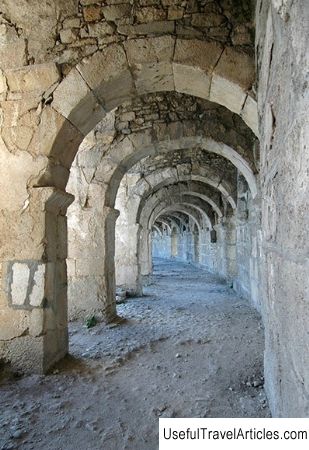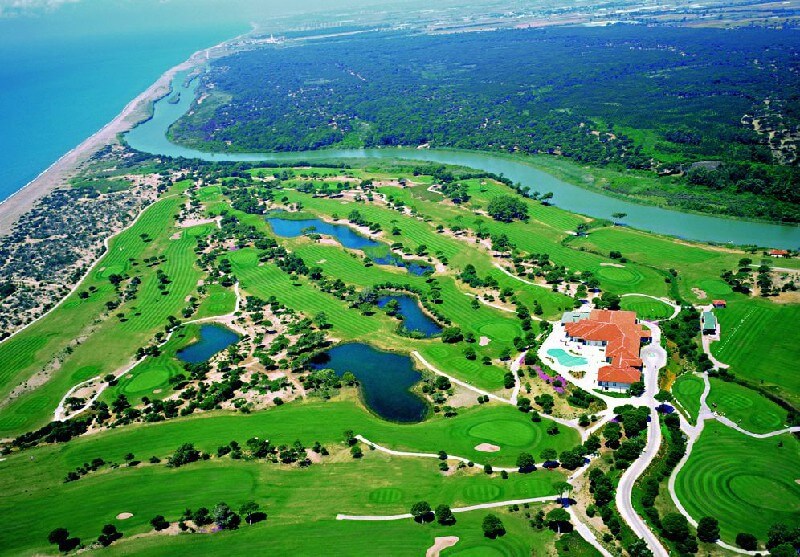Aspendos description and photos - Turkey: Antalya
Rating: 8,1/10 (532 votes) 
Aspendos description and photos - Turkey: Antalya. Detailed information about the attraction. Description, photographs and a map showing the nearest significant objects. The title in English is Aspendos. Photo and descriptionIt is believed that ancient Aspendos was founded in the fifth century BC by colonists from Argos and the founder of the city is called the soothsayer Pug. To avoid raids from the sea, the city was built at a distance of 16 km from it, on the bank of the then navigable river Euremedon (the current name of the river is Kepru). Aspendos was part of the Delhi Maritime Confederation until 425 BC. According to the historian of those times Strabo, the Persians anchored their ships here before the battle against the Athenian Naval Union, otherwise called the Delos Confederation. This rather large river trading port was seized by Alexander the Great in 333 BC. When the commander arrived in Pamphylia, the inhabitants of Aspendos convinced him not to occupy the city and in return offered 50 gold talents and a thousand horses. But they did not keep their promise, and Alexander invaded the city. In 190 BC, after the Battle of Sipila, Aspendos became part of the Roman Empire. It was during this period that the city reached its peak and became one of the three largest cities in Pamphylia. The rapid development of the city and its transformation into one of the largest shopping centers was facilitated by the mild climate and convenient location. Olive orchards and vineyards sprang up around Aspendos, and their own silver coins were minted here. In addition, it was in this city that excellent horses could be bought. The famous port and trading city sold corn, jewelry and wine. But after such a flourishing and rise, the city, like the whole of Asia Minor, fell under the rule of Byzantium and gradually fell into decay. In the 7th century, this was facilitated by the raids of the Arabs, and at the beginning of the 13th century, Aspendos was conquered by the Seljuks and soon ceased to exist. Now Aspendos is famous for its amphitheater, built in the second century and later restored by the Seljuks. The inscriptions engraved on the stones of the building in the Hellenic and Latin languages indicate that the theater was dedicated to the family of the emperor and was built with donations from the two brothers Curtius Crispin and Curtius Avspikat. The impressive size of the building allowed it to accommodate about 17 thousand spectators, and the orchestra pit was designed for 500 musicians. The theater has 39 rows of steps, 96 meters long, and the distance between them is half a meter. There is a beautiful arched gallery above the stands, which allowed the audience to stay in the shadows while attending the performances. Opposite the amphitheater is a rectangular room, which had a dressing room for actors with five doorways and a small area for performances. The wall of this room facing the hall is decorated with two rows of windows. The theater's architect Zenon designed it so that all spectators equally well hear even a whisper coming from the stage. The theater has survived better than other ancient theaters in Turkey thanks to the strength of the local limestone and the Seljuks fortified its northern wing with brickwork, when they converted it into a palace. The amphitheater, to some extent, bears the features of Greek architecture - a semicircular shape and seats for spectators located on the hillside. During the Roman era, the theater was beautifully decorated with marble and embossed with patterns and sculptures. Its splendid galleries, stage decoration, ancient ornaments and excellent acoustics still amaze visitors. The theater was discovered only in 1871, during one of the travels of the Count of Landskoy around this region. The building turned into one of the most striking historical beauties of the Anatolian Peninsula after a large-scale reconstruction in the 1950s. It regularly hosts concerts of classical music, opera and ballet performances. The theater acoustics are so good that it allows artists to perform without microphones. Such festivals usually begin in June and there are so many people who want to enjoy the spectacle that whole buses with people come from Antalya to Aspendos. The best operatic voices of the world and symphony orchestras are still performing on the stage of the theater. For example, Pink Floyd filmed a music video here for the music from the Wall album. Numerous concerts and shows were held within the walls of the theater until 2008, but now they are taking place in the arena built nearby Aspendos. The most popular show is called "The Fire of Anatolia" and is performed by the group of the same name. During the entire tourist season, it can be seen several times a week at 10 pm. The ruins of the Roman Aqueduct, which has preserved its original height, can be seen at a distance of one kilometer from the city. In ancient times, he supplied Aspendos with water. To this day, it is the largest in Turkey. Its length is more than 20 km. An ancient legend is connected with the history of the construction of the aqueduct and the Aspendos theater. The king of the city had a very beautiful daughter, Semiramis, and two architects dreamed of marrying her. Then the king said that one of the applicants could marry her, who will build the most magnificent building in the city faster. The grooms immediately got down to work and finished construction at the same time: one of them built a theater, the other an aqueduct. Both structures were magnificent and the king liked very much. Not knowing who to give preference to, the tsar suggested that the rivals divide Semiramis in half. The creator of the aqueduct agreed to this option, but the second architect chose to abandon the beauty in favor of his rival. The tsar realized that the noble author of the theater loves his daughter and would be a wonderful husband to her. Semiramis married this architect. Usually, after visiting the theater, the guides take a walk through the ruins of the city. Some of these amazing and original buildings are still preserved and make a unique impression. All the ruins that have survived to this day belong to the Roman period. From the north side of the theater you can see a very well-preserved stadium. Between the theater and the stadium, there is a path leading to the Acropolis. You can enter it through the eastern gate, one of the three gates of the city. Here you will see a part of the basilica, from which only the foundation actually remains. To the right of these buildings is a small fountain, which has only the front part. The massive buildings that meet on the way to the theater from the side of the Eurimedon River were once a gymnasium and baths. If you go further, to the regulator of the Kopryuchay river, then on the opposite bank of the river you will notice a lot of restaurants. They serve mainly tourists and have a varied and rich menu. You should definitely try meat, chicken or fish roast here.        We also recommend reading Church of Michael the Archangel description and photos - Russia - South: Temryuk Topic: Aspendos description and photos - Turkey: Antalya. |




